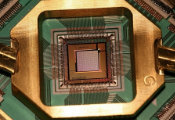HellasQCI Successfully Demonstrates Three-Node QKD Ring Network
October 2, 2024 -- In a collaborative effort by GRNET, NKUA, Nokia, EvolutionQ and ID Quantique, HellasQCI has recently published a paper highlighting the successful demonstration of a fully-managed, field-deployed, three-node Quantum Key Distribution (QKD) ring network.
The Proof-of-Concept (PoC) aims to validate HellasQCI architecture. Its network includes Layer 1 encryption at the physical layer, connecting GRNET’s and NKUA’s datacenter nodes, and covering a maximum distance of 45 kilometers.
The topology includes a 3-node full ring configuration between GRNET & NKUA, where every node is a fully integrated vertical stack featuring: A Quantum layer, A KMS layer, An Αpplication layer.
The network employs a hybrid scheme of QKD and classical yet quantum-safe centrally-generated symmetric keys to support point-to-point and relay consumers. In case of an attack or unavailability of quantum keys, the network’s capability to seamlessly transition to classical encryption with symmetric quantum-safe keys, exhibits a reliable hybrid network operation and ensures the continuous supply of keys.
The three-node network operated with only two QKD pairs, Cerberis XGR model, provided by ID Quantique. The full connectivity between all the nodes was obtained through the KMS, which processed and exchanged keys over the whole network. The standardized interfaces between the various elements and layers of the network (ETSI GS QKD 014 and ETSI GS QKD 015), were developed by the QKD working group of the European Telecommunication Standard Institute (ETSI). The availability of such standardized interfaces is paramount in the deployment of large, multi-provider, QKD networks, and is a clear sign of the maturity of QKD-based solutions.
Looking ahead and following the success of the PoC in Athens and the validation of the architecture, the next steps of the HellasQCI project include a large-scale deployment of the HellasQCI networks.




































